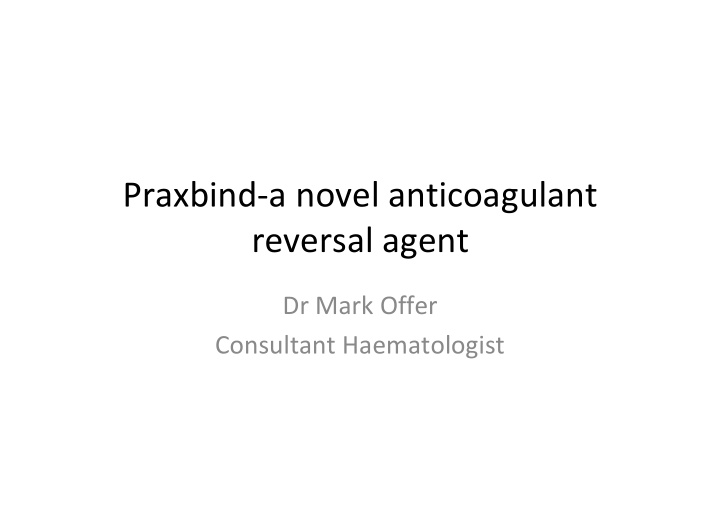



Praxbind-a novel anticoagulant reversal agent Dr Mark Offer Consultant Haematologist
The Problem • Venous Thrombosis is the third leading cause of vascular death. • Incidence rates increase from 1 per 10,000 annually among persons less than 40 years of age to nearly 1% annually among persons 80 years of age or older. • more than one third of cases occur in persons older than 60 years of age.
The Answer
Haemorrhagic Sweet Clover Disease
The Problem with the Answer
The Problem with the Answer
Newer Solutions
Dabigatran (Pradaxa) • Oral anticoagulant (DOAC) • Direct Thrombin Inhibitor • No monitoring required • Used in AF/following orthopaedic procedures • Not effective in pts with metallic heart valves • Efficacy proven in large studies • FDA (USA) approved 2010 • No antidote at approval
2015-FDA approve dabigatran antidote • Praxbind (Idarucizumab)-effective antidote to dabigatran • Dabigatran is almost completely covered making it unable to interact with thrombin. • Praxbind potently and rapidly binds to with a high affinity (350-fold more potent than the binding affinity of dabigatran for thrombin).
Praxbind binding to dabigatran
Review of uses 2016 • June-November 2016 • Praxbind issued on 4 occasions (for 4 patients)
HWPH Frimley • Held in Bloodbank • Held in pharmacy • 4 cases • Never used
4 patients
4 patients-overview Request Indication Reason for Dabigatran Clotting outcome Source for reversal dose response Dabigatran ED AF Collapse 150mg BD complete survived Intra-cerebral bleed ED AF GI bleed 150mg BD complete RIP D0 (liver cirrhosis) ED AF GI bleed 110mg BD complete RIP D+7 ED AF # femur 110mg BD 95% Survived (colostomy)
Patient 1 • 72 yr old woman-AF on dabigatran 150mg BD • Collapse at home • Low Glasgow Coma Scale • CT scan: extensive haemorrhage • APTT ratio 1.53 • Recovering on Stroke Unit
Patient 2
Patient 2 • 74 yr old man on dabigatran 150mg BD (AF) • Liver cirrhosis/aortic Stenosis/Ischaemic heart disease • On warfarin previously ? Non-tolerant • Recent admission with fall/kidney injury • Admitted with massive PR bleed • APTT ratio 5.5 • Received Vit K/RBC transfusion • Died on evening of admission
Patient 3 • 89 yr old man with AF previously on warfarin • June 2016-spontaneous retroperitoneal bleed • Anticoagulation halted for two weeks • Cardiology advice: start dabigatran 110mg BD • October 2016-Upper GI bleed • Mesenteric artery embolisation-? Pancreatic mass • Patient died on ITU
Patient 4 • 78yr old man AF on dabigatran 110mg BD • AKI stage 2/bilateral hip replacements • Aortic artery aneurysm (stented) • October 2010-fall-#pelvis • Confused • Pre-theatre request for Praxbind
Risk-assessment? • High BP • Abnormal renal function • Stroke • Bleeding condition • Labile INR • Elderly (over 65 yrs) • Drug associated with bleeding
Should Praxbind be issued by Transfusion? Pros Cons • Control by Haematologist • First in a line of NOAC antidotes • Its not a blood product but neither is Novo VII or • This is a drug not a blood Beriplex product
Measuring dabigatran effect Dilute Thrombin time ECT ecarin clotting time
Questions • Are we using the DOACs appropriately? • Who should hold the reversal agent? • How do we assess response? • Are there any better ways of anticoagulating patients?
Summary • Newer anticoagulants safer, but not risk-free • Search still on for ideal anticoagulant • We are gaining experience with newer agents.
Anticoag tomorrow
Collapse, Large Margaret Gomes 70Kg 18499Q 4.6.16/ ED AF, on dabigatran Intrcerebral bleed 150mg 04/06/2016 02:10 5g (100ml) No No 18.4/1.2 (23:55) 49/1.53 NA 33.5/1.05 Survived: On ASU AF, on dabigatran, previously on Warfarin but patient choose to 150mg prior admission, Vit k 10mg 3.9.16-fall, 24.6.16- 189.3/5.92 RIP: 19/10/2016 22:50 cause GI Peter Charles 34732N 19/10/2016 ED stop Cirrhosis, CAD Massive PR bleed 110mg as inpatient 19/10/2016, 19:05 5g (100ml) Yes 2 RBC IV ascities 77.8/4.8 (17:47) (17:47) N/A N/A haemorrhage Surgery at Frimlry on 7.7.16:Mesenteric embolisation. Transferred back to WXP W11 then Vomiting, abdo pain, 14.6.16 to ITU, developed bowel ischaemia AF,on dabigatran, PR bleeding, ITU notes Retroperitoneal due as consequence of procedure started 2 days ago, state secondary to Yes 2 RED bleed secondary to MH: 9RBC, 3FFP, 1Cryo, 1Plt. RIP Peter LEE 72.2Kg 21928H 02/07/2016 ED previously on warfarin malignancy 110mg 2.7.16, 13:00 5g (100ml) CELLS warfarin 18.2 40.5/1.27 N/A N/A 9.7.16 87.5/2.73 (25.5.16 30.5/2.0 (15:39) 10:16) 25.9/1.7 (02:58 74.7/2.33 25.5.16) 20.3/1.3 (26.5.16 (26.5.16 09:54) 09:54), 42.7/1.33 16.9/1.1 (27.5.16 60.7/1.9 28.5.16, David WEBB 24/05/2016 ED AF, AAA stents, Stoma Fall FNOF 110mg 27.5.16, 11:10 5g (100ml) 10:57) 27/5/2016 14.4 00:07 Survived
Recommend
More recommend